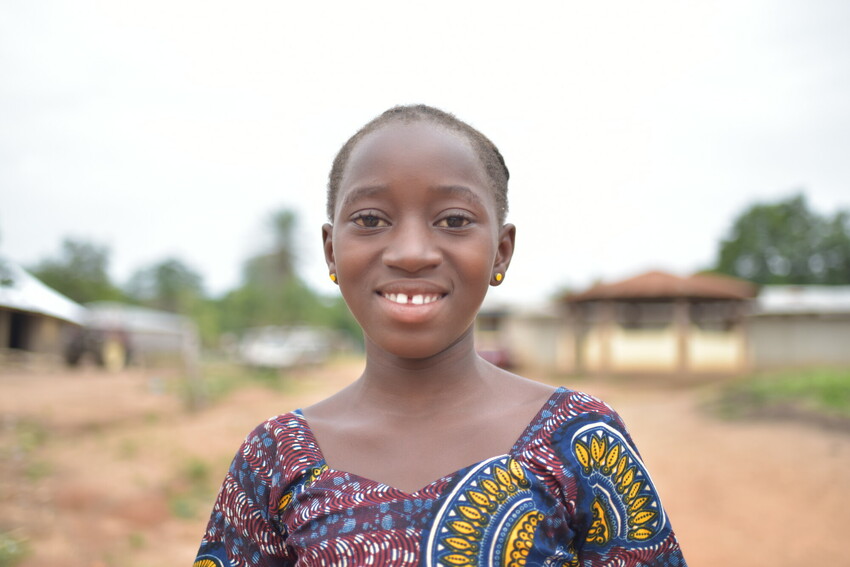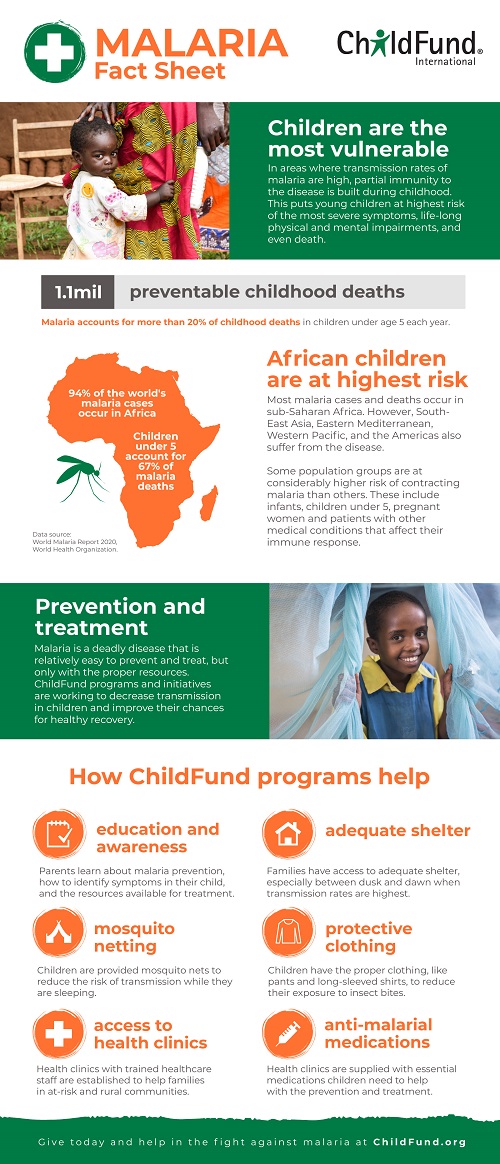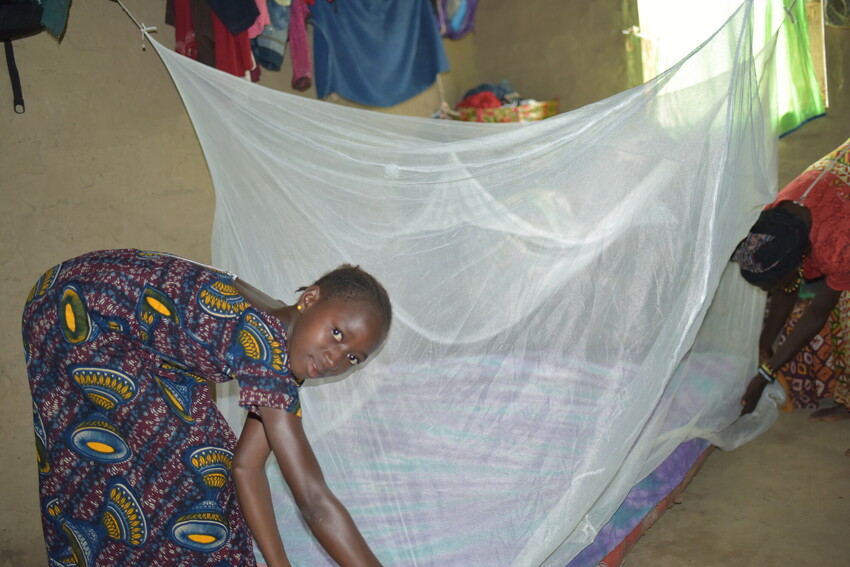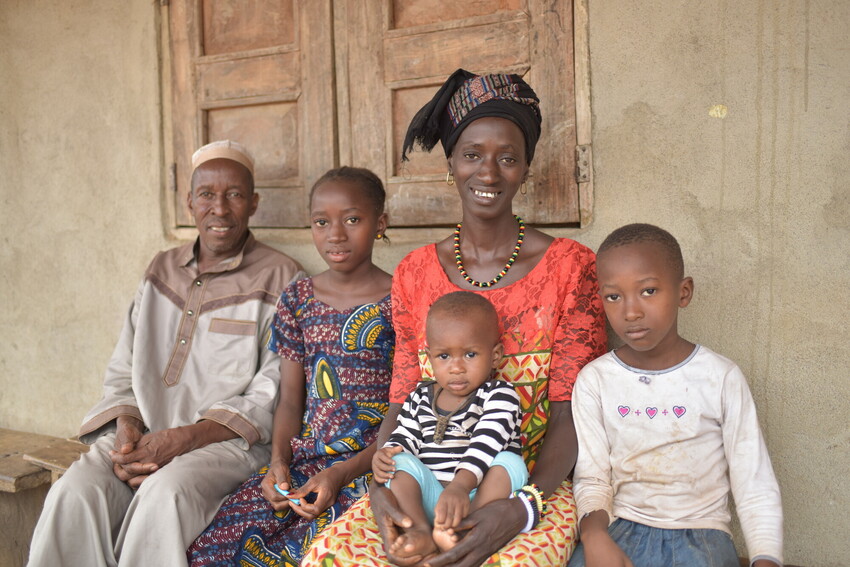Site will be
unavailable for maintenance from June. 4, 11:30 p.m., to June 5, 12:30 a.m. ET. Thank you for your
patience!
Malaria-free in Sierra Leone
Posted on 04/26/2021

For Jeneba, 13, it always started the same way.
“I would wake up to a high fever in the morning,” she says. “I’d be sweating. My body would be hot, and my head would ache. I’d be throwing up and shivering.” Then Jeneba’s mom, Kaday, would carry Jeneba on her back as she walked several miles to the nearest health center to get a diagnosis they already knew all too well: malaria.
Jeneba had battled frequent infections with the mosquito-borne disease for as long as she could remember.
“There were times when I wouldn’t go to school for a whole week,” Jeneba says. “I missed a lot during those weeks.”
What is Malaria?
Where Jeneba lives in rural Koinadugu District, Sierra Leone, malaria is an incredibly common illness that, without treatment, can quickly become deadly. Malaria is caused by a parasite that is carried and spread by mosquitoes of the genus Anopheles. Malaria risk in Africa is generally high because the continent is home to a large population of mosquitoes that carry Plasmodium falciparum, the most dangerous of the four types of parasites that cause malaria. According to the latest World Malaria Report, 94 percent of the 229 million cases of malaria reported in 2019 occurred in Africa. And 90 percent of all malaria deaths in Africa occurred in young children.

While the whole world has been busy fighting COVID-19, malaria has been having a field day. In fact, malaria risk in Africa is much higher than COVID-19 risk, and malaria has killed far more people than COVID-19. It doesn’t help that malaria and COVID-19 share some common symptoms like fever, fatigue and difficulty breathing, leading to potential misdiagnoses and delayed treatment. And, while a groundbreaking malaria vaccine is showing promising results, it will be a long time before most children in rural areas have access to it. Many communities in Africa will be vulnerable to malaria infections as long as mosquitoes exist.
For families like Jeneba’s that live below the poverty line, the economic burden of that fact is tremendous. Getting sick with malaria means having to pay for more than just medicine and transportation to a health center. It’s the high price of having to miss work or school for so long, or having to bury a family member who has unexpectedly died.
According to the Sierra Leone Malaria Control Strategic Plan 2016-2020, households in Africa spend between $2 and $25 USD on malaria treatment and between $15 and $20 on prevention each month. That’s about 3 percent of the annual income of poor households.
“After spending some time at the health center, Jeneba was tired,” says Kaday. “I was tired too. So I spent the only money we had, which was 25,000 Leones ($2.45 USD), to buy medicine and get a motorbike to return home.”
“After taking the medicine they gave us at the health center, I recovered,” Jeneba adds. “But every two or three months, I got sick again, and we kept getting the same results.”
How Do Mosquito Nets Prevent Malaria?
According to health experts, the most effective, inexpensive way to prevent malaria is to sleep inside a long-lasting insecticide-treated mosquito net (LLIN). This incredibly simple measure can be lifesaving, since malaria-carrying mosquitoes tend to bite at night.
Through our gifts in kind program, ChildFund frequently distributes these mosquito nets to children and their families. With support from an American donor, ChildFund Sierra Leone also recently distributed 28,100 mosquito nets in 10 districts, reaching 115 expectant moms and 27,965 children – including Jeneba, whose family also received a foam mattress.
Jeneba now shares the mattress and the mosquito net with her two younger siblings, Idrissa, 7, and Lamin, 2, so they can all be protected.

“Malaria was not the only thing affecting my daughter,” Kaday adds. “She would often complain of pain and cold [from sleeping on the floor]. Since getting the mattress, none of my children have complained of cold or pains.”
In addition to distributing mosquito nets, ChildFund and our partners work to raise awareness and educate communities about malaria: how to prevent it, and how critical it is to go to the health center immediately if they feel ill. In many coastal communities in Sierra Leone, for instance, people mistakenly use mosquito nets for fishing. In the communities where we work, families now understand how important it is to use the nets as intended.
The result? The annual malaria trend in Jeneba’s community is decreasing – by 79 percent in the last year, to be exact.
“Since ChildFund’s local partner workers came to talk to us about using the bed nets appropriately, I make sure I check on Jeneba and her siblings’ use of the net every night,” Kaday says. “Sometimes when they are asleep, I make sure the net is properly tucked in, just in case Jeneba forgot to.”
As for Jeneba, she can’t remember the last time she had malaria. “Since we started using the bed nets, I no longer get sick,” she says.
Our gifts in kind program is helping kids stay healthy by preventing illnesses like malaria and COVID-19, providing access to medicines and more. Donate now to make a lifesaving difference for a child like Jeneba.

Loading...


